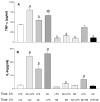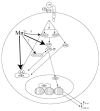Manganese-induced potentiation of in vitro proinflammatory cytokine production by activated microglial cells is associated with persistent activation of p38 MAPK
- PMID: 17845838
- PMCID: PMC2231510
- DOI: 10.1016/j.tiv.2007.07.004
Manganese-induced potentiation of in vitro proinflammatory cytokine production by activated microglial cells is associated with persistent activation of p38 MAPK
Abstract
Previous studies that investigated the role of inflammation in the neurotoxicity of manganese (Mn) found that Mn enhanced the production of inflammogen (lipopolysaccharide; LPS)-induced proinflammatory cytokines such as IL-6 and TNF-alpha. Although we have shown that the enhanced cytokine production occurs via a NF-kappaB-dependent mechanism, the role of upstream kinases in this Mn-induced enhancement has not been explored. As other studies have demonstrated that p38 mitogen activated protein kinase (p38) is necessary for LPS-induced, NF-kappaB-dependent expression of proinflammatory cytokines, we hypothesized that Mn enhancement of LPS-induced production of IL-6 and TNF-alpha may be associated with p38 activation and conducted a series of experiments to address our hypothesis. We found that pre-treatment of microglial cells with a p38-inhibitor (SB203580) prevented Mn+LPS-induced production of IL-6 and TNF-alpha. Moreover, potentiation of IL-6 and TNF-alpha production, which occurred in both concurrent and sequential (3h apart) exposures to Mn and LPS, was inhibited by inhibition of p38. Additionally, Mn exposure enhanced the phosphorylation and activity of p38 and this effect was persistent. Although p38 activity declined over time LPS-exposed cells, it persisted in cells exposed to Mn or Mn+LPS. Thus, the increased production of proinflammatory cytokines by LPS-activated microglia exposed to Mn is associated with increased and persistent activation of p38.
Figures





Similar articles
-
Manganese modulation of MAPK pathways: effects on upstream mitogen activated protein kinase kinases and mitogen activated kinase phosphatase-1 in microglial cells.J Appl Toxicol. 2011 Jan;31(1):1-10. doi: 10.1002/jat.1552. J Appl Toxicol. 2011. PMID: 20589745 Free PMC article.
-
(+)-Catechin Attenuates NF-κB Activation Through Regulation of Akt, MAPK, and AMPK Signaling Pathways in LPS-Induced BV-2 Microglial Cells.Am J Chin Med. 2015;43(5):927-52. doi: 10.1142/S0192415X15500548. Am J Chin Med. 2015. PMID: 26227399
-
Gastrodin inhibits expression of inducible NO synthase, cyclooxygenase-2 and proinflammatory cytokines in cultured LPS-stimulated microglia via MAPK pathways.PLoS One. 2011;6(7):e21891. doi: 10.1371/journal.pone.0021891. Epub 2011 Jul 12. PLoS One. 2011. PMID: 21765922 Free PMC article.
-
Manganese potentiates LPS-induced heme-oxygenase 1 in microglia but not dopaminergic cells: role in controlling microglial hydrogen peroxide and inflammatory cytokine output.Neurotoxicology. 2011 Dec;32(6):683-92. doi: 10.1016/j.neuro.2011.09.002. Epub 2011 Sep 25. Neurotoxicology. 2011. PMID: 21963524 Free PMC article.
-
Anti-Inflammatory and Anti-Migratory Activities of Isoquinoline-1-Carboxamide Derivatives in LPS-Treated BV2 Microglial Cells via Inhibition of MAPKs/NF-κB Pathway.Int J Mol Sci. 2020 Mar 27;21(7):2319. doi: 10.3390/ijms21072319. Int J Mol Sci. 2020. PMID: 32230861 Free PMC article.
Cited by
-
Consequences of Disturbing Manganese Homeostasis.Int J Mol Sci. 2023 Oct 6;24(19):14959. doi: 10.3390/ijms241914959. Int J Mol Sci. 2023. PMID: 37834407 Free PMC article. Review.
-
Yin Yang 1 is a repressor of glutamate transporter EAAT2, and it mediates manganese-induced decrease of EAAT2 expression in astrocytes.Mol Cell Biol. 2014 Apr;34(7):1280-9. doi: 10.1128/MCB.01176-13. Epub 2014 Jan 27. Mol Cell Biol. 2014. PMID: 24469401 Free PMC article.
-
Behavioral Alterations in Mice Exposed to Manganese via Drinking Water: Effects of Sex and a Lipopolysaccharide Challenge.J Appl Toxicol. 2025 Apr;45(4):669-684. doi: 10.1002/jat.4739. Epub 2024 Dec 8. J Appl Toxicol. 2025. PMID: 39647842 Free PMC article.
-
Blockage of KHSRP-NLRP3 by MCC950 Can Reverse the Effect of Manganese-Induced Neuroinflammation in N2a Cells and Rat Brain.Int J Mol Sci. 2022 Oct 30;23(21):13224. doi: 10.3390/ijms232113224. Int J Mol Sci. 2022. PMID: 36362011 Free PMC article.
-
Synergistic dopaminergic neurotoxicity of manganese and lipopolysaccharide: differential involvement of microglia and astroglia.J Neurochem. 2010 Jan;112(2):434-43. doi: 10.1111/j.1471-4159.2009.06477.x. Epub 2009 Nov 6. J Neurochem. 2010. PMID: 19895668 Free PMC article.
References
-
- Aschner M, Aschner JL. Manganese neurotoxicity: Cellular effects and blood-brain barrier transport. Neuroscience Biobehavior Review. 1991;15:334–340. - PubMed
-
- Bae JH, Jang BC, Suh SI, Ha E, Baik HH, Kim SS, Lee MY, Shin DH. Manganese induces inducible nitric oxide synthase (iNOS) expression via activation of both MAP kinase and PI3K/Akt pathways in BV2 microglial cells. Neuroscience Letters. 2006;398:151–154. - PubMed
-
- Bhat NR, Zhang P, Lee JC, Hogan EL. Extracellular signal-regulated kinase and p38 subgroups of mitogen-activated protein kinases regulate inducible nitric oxide synthase and tumor necrosis factor-a gene expression in endotoxin-stimulated primary glial cultures. Journal of Neuroscience. 1998;18:1633–1641. - PMC - PubMed
-
- Carter AB, Knudtson KL, Monick MM, Hunninghake GW. The p38 mitogen-activated protein kinase is required for NF-κB-dependent gene expression. Journal of Biological Chemistry. 1999;274:30858–30863. - PubMed
Publication types
MeSH terms
Substances
Grants and funding
LinkOut - more resources
Full Text Sources
Research Materials

